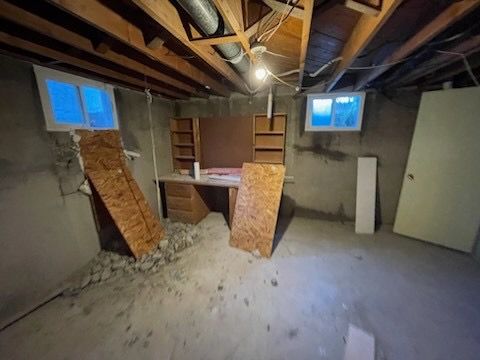Basement Finishing: A Complete Guide

Complete Basement Finishing Guide
A basement is often the most underused space in a home. Finishing it transforms it into valuable, functional living space. Whether you want a cozy entertainment room, a home office, or an extra bedroom, a finished basement offers endless possibilities.
So, where do you begin? Basement finishing goes beyond just adding walls and flooring. It’s about creating a safe, durable, and inviting space that fits your needs and lifestyle. This guide gives you step-by-step advice on planning, designing, and avoiding common mistakes.
By the end, you’ll have the tools to confidently start your basement project and make it a space you’ll love.
What Is Basement Finishing?
Basement finishing transforms an unfinished basement into a functional living space. This process includes adding walls, flooring, insulation, and proper lighting to make the space livable and comfortable.
It’s different from basement remodeling, which focuses on redesigning an already finished space. Basement finishing gives you a blank canvas to create something new and tailored to your needs.
Common Uses for Finished Basements
Home Entertainment Area
A finished basement is perfect for creating a dedicated entertainment zone. Add a large TV, surround sound, and cozy seating for movie nights or hosting game-day gatherings.
Guest Suite
Transform your basement into a comfortable guest room. Include a bathroom and some thoughtful touches to give visitors a private, welcoming space.
Home Office or Workspace
More people are working remotely, and basements offer a quiet place for a focused home office. With good lighting, ergonomic furniture, and some décor, it becomes the ideal workspace.
Fitness Room
Skip the gym and turn your basement into a home workout space. Add rubber flooring, mirrors, and gym equipment to stay active without leaving your house.
Multi-Purpose Family Room
A basement can serve as a flexible family space—a playroom for kids, a hobby area, or just an extra room for relaxing together.
Benefits of Finishing Your Basement
Finishing your basement offers more than just additional space. It provides practical and financial advantages that enhance your home’s value and functionality.
Increased Home Value
A finished basement significantly boosts your property’s value. According to real estate experts, homeowners can see an average return on investment (ROI) of 70% or more. Buyers often prefer homes with finished basements, making it a smart financial decision if you plan to sell in the future.
Additional Living Space
A finished basement gives you extra usable square footage, perfect for growing families or changing needs. Whether it’s a playroom for kids, a guest suite, or a personal office, this space can adapt to your lifestyle.
Improved Energy Efficiency
Basement finishing often includes adding insulation and energy-efficient materials, which help lower heating and cooling costs. A well-insulated basement can reduce drafts and keep your home comfortable year-round.
Protection Against Moisture and Mold
Properly finishing your basement addresses moisture issues, helping prevent water damage and mold growth. This ensures a safe and healthy environment for your family. Waterproofing and sealing the foundation are key steps to achieving this benefit.
Key Considerations Before Starting Your Basement Finishing Project
Before jumping into a basement finishing project, it’s crucial to plan carefully. This ensures your project runs smoothly and avoids costly mistakes. Here are the most important factors to consider.
Local Building Codes and Permits
Check your local building codes and obtain the necessary permits before starting. Many areas have specific regulations for electrical work, plumbing, and safety requirements. Working without permits could lead to fines or issues when selling your home.
Budget Planning
Set a realistic budget to keep your project on track. The average cost to finish a basement ranges from $30 to $75 per square foot, depending on the materials and design. Include a buffer for unexpected expenses like hidden water damage or structural fixes.
Tips for Budgeting:
- Get quotes from multiple contractors.
- Prioritize must-haves over nice-to-haves.
- Research affordable yet durable materials.
Moisture and Waterproofing
Basements are prone to moisture problems, which can lead to mold and damage. Address any leaks or water issues before finishing. Consider waterproofing the walls and floors, installing a sump pump, or using a dehumidifier to keep the space dry.
Structural Integrity
Inspect your basement for structural concerns like cracks in the foundation or sagging beams. These issues should be fixed before finishing to ensure the safety and longevity of your basement. Consult a professional if you notice anything concerning.
Utilities
Plan for any necessary upgrades to HVAC, plumbing, or electrical systems. For example:
- HVAC: Ensure proper ventilation and heating.
- Plumbing: Add rough-ins for bathrooms or wet bars.
- Electrical: Include additional outlets and lighting fixtures to meet your needs.
Step-by-Step Basement Finishing Process
Transforming your basement into a functional space requires careful planning and execution. Follow these steps to ensure a smooth and successful project.
Step 1: Planning and Design
Start by creating a clear vision for your basement.
Determine the Purpose: Will it be a guest room, an office, or an entertainment area?
Layout Design: Plan the placement of walls, lighting, and utilities.
Hire Professionals or DIY: Decide if you’ll handle the project yourself or bring in experts for certain tasks.
A well-thought-out design saves time and money by reducing changes later.
Step 2: Preparing the Basement
Preparation is key to a durable and comfortable basement.
Clear the Space: Remove clutter and debris for a clean workspace.
Inspect for Moisture: Check for leaks, cracks, or damp spots and fix them before starting.
Apply Waterproofing: Seal walls and floors to protect against water damage.
Step 3: Framing and Insulation
Framing: Build the walls and any new rooms using studs and framing materials.
Insulation: Add insulation to regulate temperature and improve energy efficiency. Spray foam and fiberglass are common choices.
Step 4: Electrical and Plumbing
This step requires careful planning and professional help if needed.
Electrical: Install outlets, light fixtures, and wiring for entertainment systems.
Plumbing: Add pipes and fixtures if you’re including a bathroom or wet bar.
Ensure this work meets local building codes.
Step 5: Drywall and Flooring Installation
Drywall: Hang and finish drywall for smooth walls. Use moisture-resistant drywall for added durability.
Flooring: Choose materials like vinyl planks, tile, or carpet that suit the purpose of your basement.
Step 6: Finishing Touches
Bring your basement to life with these final details:
Painting: Use light, neutral colors to brighten the space.
Lighting: Install overhead lights, sconces, or lamps to create a welcoming atmosphere.
Décor and Furniture: Add personal touches like rugs, artwork, and cozy furniture to make the space feel complete.
Common Basement Finishing Challenges and How to Overcome Them
While finishing your basement can be rewarding, it comes with its own set of challenges. Here are the most common issues and practical solutions to handle them.
Dealing with Low Ceilings
Basements often have low ceilings, which can make the space feel cramped.
Solution:
- Use recessed lighting instead of hanging fixtures to maximize vertical space.
- Paint the ceiling and walls in light colors to create an open, airy feel.
- If possible, lower the floor by excavating to gain extra height, but consult a professional as this can be complex.
Addressing Lighting Issues
Basements typically lack natural light, making them feel dark and unwelcoming.
Solution:
- Install plenty of LED lighting to brighten the area.
- Use floor lamps and wall sconces for ambient lighting.
- Add egress windows where possible to let in natural light and improve safety.
Managing Noise from Upper Floors
Noise from upstairs can travel easily into a finished basement, disrupting its functionality.
Solution:
- Install soundproofing insulation in the ceiling.
- Use acoustic panels or carpets to reduce noise levels.
- Consider adding drop ceilings with soundproofing tiles for extra noise reduction.
Preventing Water Damage
Water is one of the biggest risks in a finished basement. Even small leaks can cause significant damage.
Solution:
- Waterproof the basement before finishing, including sealing cracks and using moisture barriers.
- Install a sump pump and maintain your drainage system to keep water out.
- Use water-resistant materials for flooring and walls to protect against unexpected leaks.
Staying Within Budget
Unforeseen costs can derail your budget if you’re not careful.
Solution:
- Create a detailed budget and stick to it.
- Get quotes from multiple contractors and compare pricing.
- Save on labor costs by handling small tasks, like painting, yourself.
Cost Breakdown and Budgeting Tips
Finishing a basement is a worthwhile investment, but it’s essential to plan your budget carefully. Here’s a breakdown of costs and tips to help you stay on track.
Average Cost to Finish a Basement
The cost of finishing a basement typically ranges from $30 to $75 per square foot, depending on the size, design, and materials used.
Common Cost Categories:
- Framing and Insulation: $1,500–$4,000
- Electrical and Plumbing: $2,000–$5,000
- Drywall Installation: $1,500–$3,000
- Flooring: $1,500–$4,500 (depends on material choice)
- Painting and Finishing Touches: $1,000–$2,500
Keep in mind that high-end features like a custom wet bar, theater room, or luxury bathroom can increase the total cost significantly.
Factors That Affect Cost
Several variables impact the total expense of your project:
- Basement Size: Larger basements naturally cost more to finish.
- Design Complexity: Custom layouts and unique features like built-in furniture or lighting increase costs.
- Material Quality: Higher-end materials, such as hardwood flooring or quartz countertops, add to the budget.
- Labor Costs: Hiring professionals often makes up a large portion of the expenses, but ensures quality work.
Tips for Staying on Budget
Get Multiple Quotes
Reach out to several contractors and compare their pricing. This helps you find the best value for your investment.
Prioritize Your Needs
Focus on must-haves, like insulation and lighting, before splurging on luxury finishes. You can always upgrade later.
Choose Cost-Effective Materials
Look for durable yet affordable options, such as vinyl plank flooring instead of hardwood or pre-finished drywall instead of custom paneling.
Plan for Unexpected Costs
Set aside 10–15% of your budget for surprises like fixing water damage or upgrading utilities.
With careful planning and smart choices, you can create a stunning basement without overspending.
DIY vs. Hiring a Professional for Basement Finishing
When it comes to finishing your basement, you have two main options: do it yourself or hire a professional contractor. Each approach has its pros and cons, and the right choice depends on your budget, time, and skill level.
DIY Basement Finishing
Pros
- Cost Savings: By handling the labor yourself, you can save a significant amount on contractor fees.
- Full Control: You have complete oversight of the project, from material selection to final touches.
- Personal Satisfaction: Completing a basement yourself can be incredibly rewarding.
Cons
- Time-Consuming: DIY projects often take longer, especially if you’re learning as you go.
- Risk of Mistakes: Errors in insulation, wiring, or waterproofing can be costly to fix later.
- Limited Expertise: Certain tasks, like electrical and plumbing, may require professional skills to meet building codes.
Best for:
Homeowners with construction experience or those tackling smaller, less complex projects like painting or flooring.
Hiring a Professional
Pros
- Quality Workmanship: Professionals have the experience to deliver high-quality, durable results.
- Faster Completion: Contractors can work efficiently to complete your basement on schedule.
- Code Compliance: Licensed contractors ensure your project meets local building regulations.
- Problem-Solving: Experts can identify and address hidden issues, like structural damage or water leaks, before they become bigger problems.
Cons
- Higher Cost: Hiring professionals is more expensive upfront due to labor and expertise fees.
- Less Control: You’ll rely on the contractor’s timeline and process, which might not always align with your preferences.
Best for:
Homeowners who want a stress-free, polished result or are dealing with complex projects that involve plumbing, electrical work, or structural changes.
Finding the Right Contractor
If you decide to hire a professional, choose wisely:
- Ask for References: Speak to previous clients about their experience.
- Check Credentials: Ensure the contractor is licensed, insured, and experienced in basement finishing.
- Compare Quotes: Get detailed estimates from multiple contractors to find the best value.
Whether you go the DIY route or hire a pro, the key is making informed decisions to create a space you’ll love.
Design Ideas and Inspiration for Finished Basements
When it comes to designing your finished basement, the possibilities are endless. Whether you prefer a cozy retreat or a modern multi-purpose area, the right design can transform your space into something unique and functional. Here are some popular ideas to inspire your project.
Popular Design Styles
Modern Minimalist
Focus on clean lines, neutral colors, and open spaces. Use sleek furniture, recessed lighting, and simple décor for a fresh, uncluttered look.
Rustic Charm
Incorporate natural materials like wood and stone for a warm, inviting atmosphere. Exposed beams, brick walls, and earthy tones can give your basement a cozy, rustic vibe.
Industrial Look
For a bold, edgy design, embrace exposed pipes, concrete flooring, and metal accents. Pair this with soft lighting to balance the raw materials with a comfortable ambiance.
Creative Use Cases for Finished Basements
Home Theater
Turn your basement into a cinematic escape. Add a large screen, surround sound, and comfortable seating to enjoy movie nights in style.
Game Room
Include a pool table, arcade machines, or a poker table for the ultimate entertainment hub. Don’t forget a small bar for refreshments!
Home Gym
Create a dedicated fitness space with durable flooring, mirrors, and gym equipment. Add a small storage area for yoga mats, weights, and resistance bands.
Kids’ Playroom
Make a fun, safe environment for kids to play and learn. Use colorful furniture, storage for toys, and soft flooring for comfort and safety.
Multi-Purpose Space
Combine several functions into one versatile area. For example, a family room that doubles as a guest suite with a fold-out couch or a home office that transitions into a hobby space.
Tips for Personalizing Your Basement
- Use Accent Walls: A bold color or textured wall can add personality to the space.
- Add Built-In Shelving: Maximize storage while keeping the area stylish and organized.
- Incorporate Art and Décor: Showcase your personality with artwork, rugs, or unique lighting fixtures.
A thoughtfully designed basement not only enhances your home but also provides a space tailored to your lifestyle.
Maintenance Tips for Your Finished Basement
Once your basement is finished, proper maintenance ensures it stays comfortable, functional, and free from damage. A little care goes a long way in protecting your investment.
Keep the Space Moisture-Free
Use a Dehumidifier: Basements naturally attract moisture. A dehumidifier helps maintain an ideal humidity level of 30–50%.
Check for Leaks Regularly: Inspect windows, walls, and floors for signs of water intrusion. Address leaks immediately to prevent mold or structural damage.
Maintain the Sump Pump: Test your sump pump periodically to ensure it works during heavy rains or flooding.
Inspect the Structure Periodically
Look for Cracks: Check walls and floors for new cracks that may indicate foundation shifts. Repair them promptly.
Monitor Insulation: Ensure insulation stays dry and intact to maintain energy efficiency.
Protect Flooring
Clean Regularly: Sweep or vacuum floors to remove dirt and debris.
Use Waterproof Mats: Place mats in areas prone to spills, such as near wet bars or entry points.
Reseal as Needed: If you’ve installed concrete or tile floors, reseal them every few years to prevent wear and tear.
Maintain HVAC Systems
Change Air Filters: Regularly replace air filters in HVAC systems to maintain air quality.
Check Ventilation: Ensure all vents are clear and functioning properly to keep the basement well-ventilated.
Keep Pests Out
Seal Gaps: Close any gaps or openings in walls and around windows to keep pests out.
Store Food Properly: If your basement includes a kitchenette or bar, store food in airtight containers to avoid attracting bugs.
By following these maintenance tips, you’ll preserve the quality of your finished basement and enjoy it for years to come.
Conclusion
Finishing your basement is one of the best ways to add value, functionality, and comfort to your home. Whether you’re creating a home office, entertainment room, or guest suite, the possibilities are endless. With proper planning, attention to detail, and the right team by your side, you can transform your basement into a space that fits your lifestyle and enhances your home’s appeal.
If you’re ready to take the next step, trust Foundation Finishes to bring your vision to life. Our team specializes in high-quality basement finishing and remodeling, ensuring every detail is handled with care. From waterproofing and framing to the final coat of paint, we deliver durable and beautiful results. Contact us today for a free consultation and let’s create a space you’ll love!


